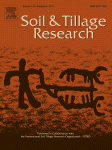Ver ítem
- xmlui.general.dspace_homeCentros e Institutos de InvestigaciónCIRN. Centro de Investigaciones de Recursos NaturalesInstituto de SuelosArtículos científicosxmlui.ArtifactBrowser.ItemViewer.trail
- Inicio
- Centros e Institutos de Investigación
- CIRN. Centro de Investigaciones de Recursos Naturales
- Instituto de Suelos
- Artículos científicos
- Ver ítem
Soil structure and glyphosate fate under no-till management in the Pampa region. I. Soil structural anisotropy and hydro-physical behavior
Resumen
Several studies have reported a frequent occurrence of platy structures in soils under no tillage (NT), mostly in silty ones. The objective of this study was to evaluate the morphological features and the pore architecture of a soil under NT and their effects on hydro-physical variables. The study was conducted on a Typic Argiudoll in a site located in the Rolling Pampa, NE of the Buenos Aires province, Argentina. The experimental area was a patch 50 m2,
[ver mas...]
Several studies have reported a frequent occurrence of platy structures in soils under no tillage (NT), mostly in silty ones. The objective of this study was to evaluate the morphological features and the pore architecture of a soil under NT and their effects on hydro-physical variables. The study was conducted on a Typic Argiudoll in a site located in the Rolling Pampa, NE of the Buenos Aires province, Argentina. The experimental area was a patch 50 m2, in which rainfall simulation and soil sampling were performed in four sub-plots. Soil structural features were determined by direct visual observation of monoliths and individual aggregates, and by micromorphological and micromorphometric analyses on thin sections. Occurrence of platy structure resulting from cultivation was evident in all sub-plots. A strong vertical anisotropy characterized the topsoil and different morphological types (Platy, Open Platy and Dense) were identified.Rainfall simulations were employed to determine infiltration rate, runoff and sediment yield, which show a high spatial variability. Total porosity, pore size and type and orientation of aggregates and pores appeared to be the main factors explaining the slow infiltration and the great variability of hydrological parameters. The results obtained indicate that a detailed study of structure and porosity of soils cultivated under NT can help to evaluate the effects of this practice on their physical health and behavior.
[Cerrar]

Autor
Behrends Kraemer, Filipe;
Sainz, Daiana Soledad;
Morras, Héctor José María;
Carfagno, Patricia;
Eiza, Maximiliano Joaquin;
Fernandez, P.;
Chagas, Celio Ignacio;
Fuente
Soil and Tillage Research 221: 105410 (July 2022)
Fecha
2022-05-03
Editorial
Elsevier
ISSN
0167-1987
Formato
pdf
Tipo de documento
artículo
Palabras Claves
Derechos de acceso
Restringido
 Excepto donde se diga explicitamente, este item se publica bajo la siguiente descripción: Creative Commons Attribution-NonCommercial-ShareAlike 2.5 Unported (CC BY-NC-SA 2.5)
Excepto donde se diga explicitamente, este item se publica bajo la siguiente descripción: Creative Commons Attribution-NonCommercial-ShareAlike 2.5 Unported (CC BY-NC-SA 2.5)

